With their sleepy demeanour, slow movements and seemingly smiling faces, the sloths of Central and South America (one of the world's cutest animals) have won over the hearts of people around the world, inspiring memes a-plenty.
What are sloths?
Sloths are suspensorial mammals
Where do sloths live?
Sloths are quintessentially arboreal animals, rarely leaving the canopy of tropical forests of Central and South America.
In the canopy they sleep, rest, move, travel, eat and mate. They move around their rather small home ranges (generally smaller than 10 hectares) along tree branches, tangled lianas and vines in search for their preferred food, tree leaves.
How do two-toed and three-toed sloths differ?
Both Bradypus and Choloepus sloths have three fingers on their hindfeet, but differ in the number of fingers on the forefeet:
Choloepus, the two-toed sloths, have two fingers as the name implies while Bradypus, the three-toed sloths, have three fingers.
How many species of sloth are there?
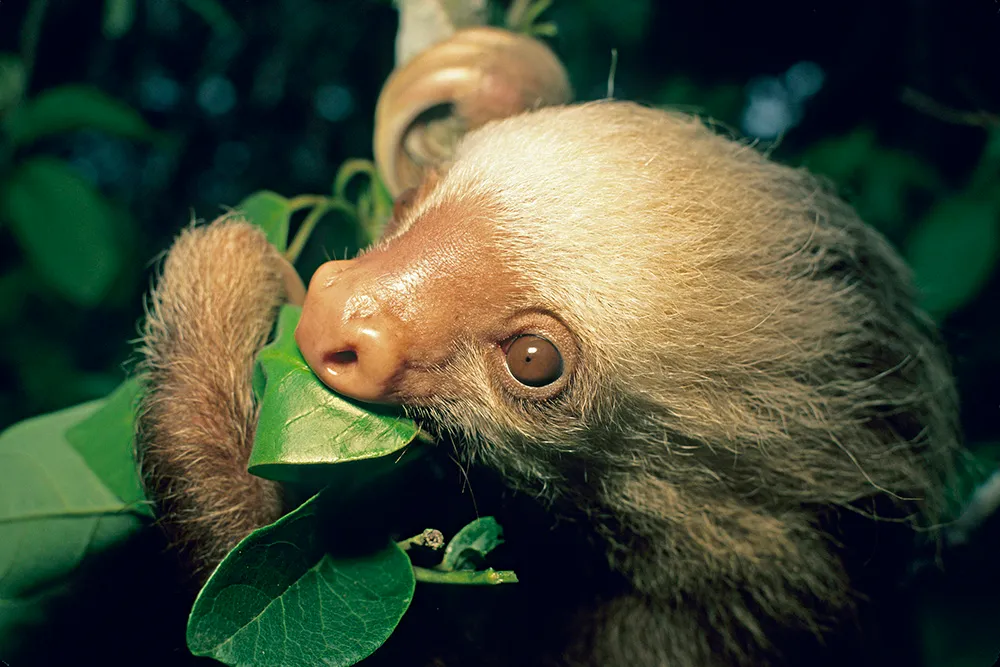
There are six species of sloths, two species in the Choloepus genus and four species in the Bradypus genus.
Choloepus genus:
- Hoffmann’s sloth (C. hoffmanni)
- Linne’s sloth (C. didactylus)
Bradypus genus:
- Pygmy sloth (B. pygmaeus)
- Brown-throated sloth (B. variegatus)
- Pale-throated sloth (B. tridactylus)
- Maned sloth (B. torquatus).
Are sloths social?
Sloths are solitary animals so they don't live in groups – except, of course, during motherhood and mating. Mother and infant can live together for as long as a year.
After that either the infant disperses to another territory or the mother does instead, and both live all by themselves.
During mating, male and female can stay close together for a couple of hours or sometime even a few days, but after copulating, both return to their solitary lives.
Quite a few information exist on sloth mating in the wild but thanks to genetic analyses it seems that a male can copulate with more than one female and the females can copulate with more than one male, although fidelity to a single male might also happen among females.
So their mating system is both polygynic (one male copulating with more than one female) and promiscuous (both male and female can copulate with more than one partner during their reproductive lives) and this system seems to apply to both two-toed and three-toed sloths.
What does the word slow mean?
The word ‘sloth’ is related to ‘slow’ and their common names in other languages also reference being lazy or slow.
How big do sloths grow?
Two-toed sloths are in general larger and heavier than Bradypus sloths, but some maned sloths (B. torquatus) can reach similar size and weight to the two-toed sloths, at about 60-70 cm of body-length and 7-10 kg of body weight.
The smallest sloth is the pygmy sloth (B. pygmaeus) measuring 45-50 cm and weighing 3.5-4.5 kg. Sloths are born tiny and it takes about three-four years to reach adulthood, sometimes more, sometimes less depending upon the environment.
Why do sloths have a patch on their back?

Males of the brown and pale-throated sloths generally have a stripe of black hair down the middle of their back and this stripe is surrounded by yellow or orange hairs.
This different looking patch of hairs is called speculum and can have different shapes and sizes but is generally very conspicuous so that one can see it from a distance.
We don´t know yet its exact purpose, but since only adult males present the largest and brightest speculums, we reason that they might signal male sexual maturity to other sloths.
Although this might appear as one more example of secondary sexual dimorphism, which is rather common among mammals and birds (like a male lion mane, for example) it is weird to find it in an animal with such a poor eye-sight, like all sloths have.
Therefore, sloths might have difficulty in visually differentiating individuals with or without speculums on their backs. More research is needed on this topic.
Why are sloths covered in algae?
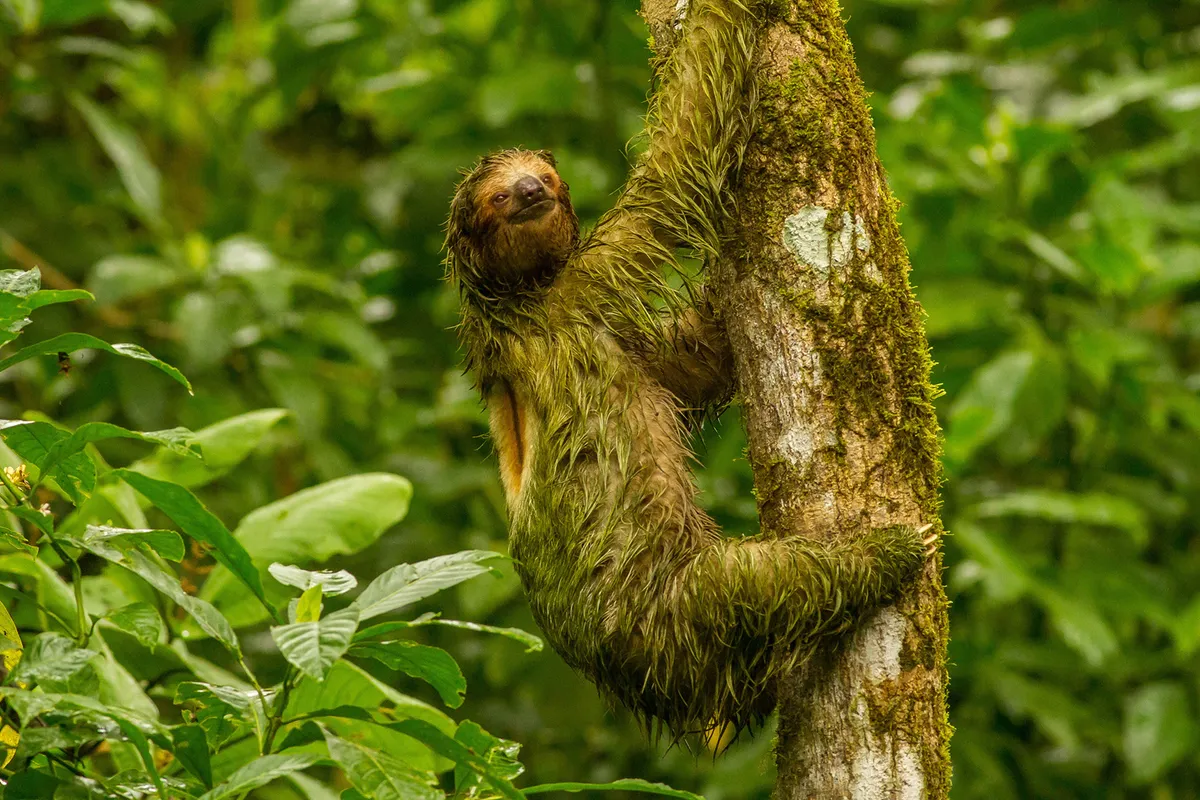
The sloth pelage is long and shaggy and microscopically the hairs have crevices and cracks that facilitate the fixation of several species of algae.
This favourable substrate in combination with their life style, exposed to sun light high up in the forest canopy permit the growth of several species of algae.
During the wet season the algae can grow more and become visible to the human eye giving a greenish coloration to the pelage. Some studies suggest that these algae are commensals, that is, they do not harm nor help their hosts.
Some research hypothesises however that algae and sloths might have a mutualistic relationship, where both benefit: sloths providing a substrate and protection for the algae which, in turn, provide some nutrients (minerals) to the sloths.
While this might sound interesting and perhaps plausible, how these algae-based nutrients get inside the sloths so as to be useful to them is not known.
Since sloths don’t lick their pelage as several mammal species do (like our dogs and cats) these nutrients might not be ingested, so the most obvious mechanism is discarded but perhaps they can be absorbed directly from the skin. Future research is definitely needed to clarify this interesting possibility.
How do sloths contribute to biodiversity?
Sloths can reach high density representing a significant portion of the mammalian biomass existing in the canopy of Tropical forests.
By being numerous, sloths represent an important link of the food web of Neotropical forests, being preyed upon by large raptors such as the harpy eagle, large cats like jaguars, pumas and sometimes even by smaller predators such as the ocelot and the tayra.
The sloth pelage is host to several species of microorganisms, algae, fungi and small invertebrates such as ticks, moths and even beetles (see below). Further, sloths also contribute to the nutrient cycling through defecation and urination.
Why do sloths look like they are always smiling?
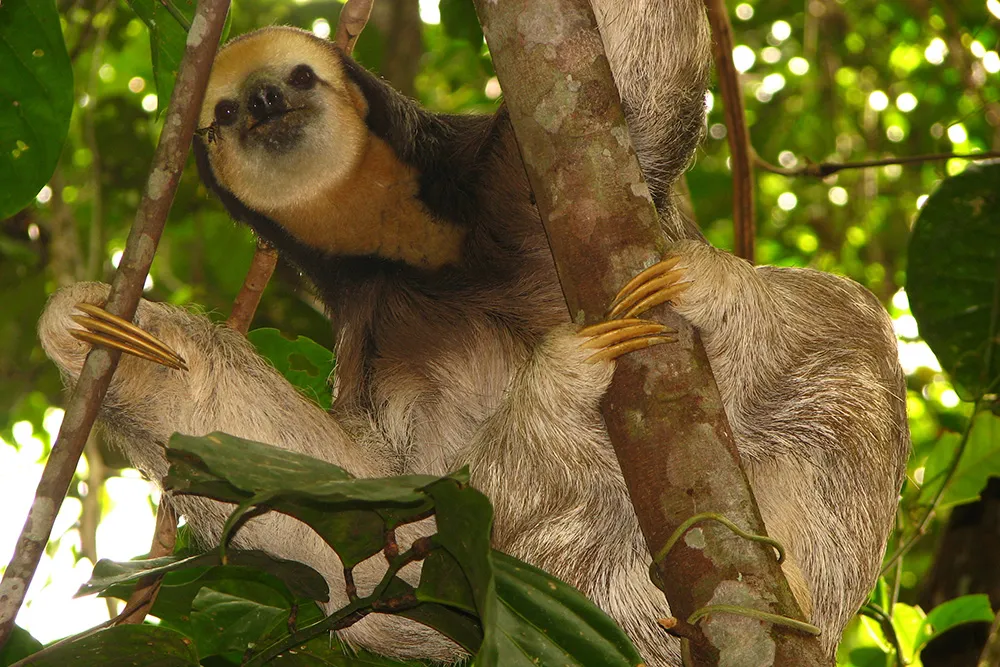
This is just an artefact of the morphology and colouration of their face and snout since sloths are not able to “smile” or, putting it another way, are not able to modify their facial expression like, for instance, monkeys, cats, dogs and several other mammals.
Happy or not, a sloth face is always the same. This, however, does not mean that they are not able to demonstrate distress, which they do in a variety of ways.
If threatened by an aggressor (human or animal), for example, two-toed sloths try to bite the aggressor rather ferociously or try to grab it with fast swings of their arms.
Both strategies work to intimidate the aggressor. Both sloths also emit vocalizations and can exhale air from their nose, producing a menacing sound.
Are sloths nocturnal?
Two-toed sloths are strictly nocturnal but three-toed sloths can be nocturnal, diurnal or even cathemeral (active both day and night).
In fact, some studies show that even individuals of the same population can show contrasting activity patterns. Why they do so or what drives these differences in behaviour remains unanswered.
How do sloths move on the ground?

Sloths only go to the ground in two circumstances: to defecate and urinate once every 5-7 days or when they cannot move along the canopy due to lack of connection between adjacent trees.
Sloths don't have the ability, typical of monkeys, to jump from branch to branch or from tree to tree. They never do that.
So when the spaces between two adjacent trees are more than the reach of their arms and claws, rather reluctantly they go down the tree, reach the forest floor, slowly move themselves along the ground, and as soon as possible ascend to the canopy again either climbing a tree trunk or a vine or liana.
In fact sloths are so superbly adapted to the canopy life that their arms and feet anatomy and musculature are not at all suited to propel the animal on the ground's level. Once there, they literally drag themselves.
Given this, they become very vulnerable to predation to ground predators in such instances. So why then both two- and three-toed sloths go to the ground to defecate? Why on Earth don't they poo from the canopy? This question has puzzled researchers for decades and still remains unanswered.
Several hypotheses have been proposed, including a supposed mutualistic relationship between sloths and their preferred tree, which would be fertilized by the nutrients released by the sloths' faeces and urine.
Can sloths swim?
Please note that external videos may contain ads:
Swimming Sloth Searches For Mate | Planet Earth II | BBC Earth
Yes, sloths are excellent swimmers, and have been witnessed crossing even very large rivers in the Amazon.
In fact they swing their arms and feet more quickly when in the water than when in their natural habitat.
How do sloths mate?
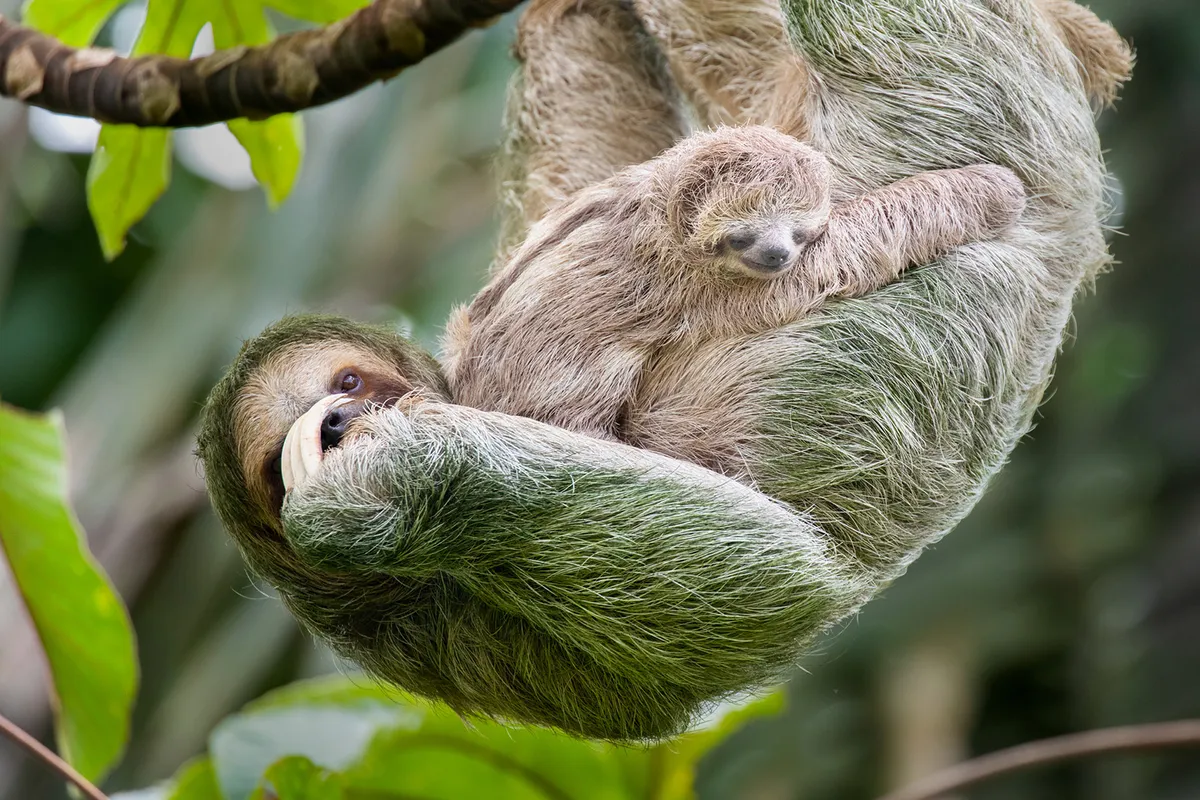
Sloths mate once a year and produce one infant per parturition, rarely twins. Infants suckle from their mothers for a few months but remain with them for about a year.
Two-toed sloths have a longer gestation period of around 10 months, while in three-toed sloths gestation lasts for about six months.
Why are sloths so slow?
Sloths are folivores, feeding on tree leaves which takes a long time to digest and delivers little energy per unit weight. So they get few calories from their food.
Apart from that sloths, like all Xenarthrans, the group where sloths belong together with anteaters and armadillos, have a low metabolism.
In other words, they require a small amount of energy to perform their everyday activities. So evolutionary speaking this predisposition to require small amounts of energy, characteristic of Xenarthrans, has been maximized even further in sloths given their energy-poor diet.
In short, they don't have energy to go move fast. But there is one more reason behind this slothfulness. By spending little energy, moving slowly and silently sloths attract the attention of few predators. So being slow-moving is adaptive!
How do sloths save energy?
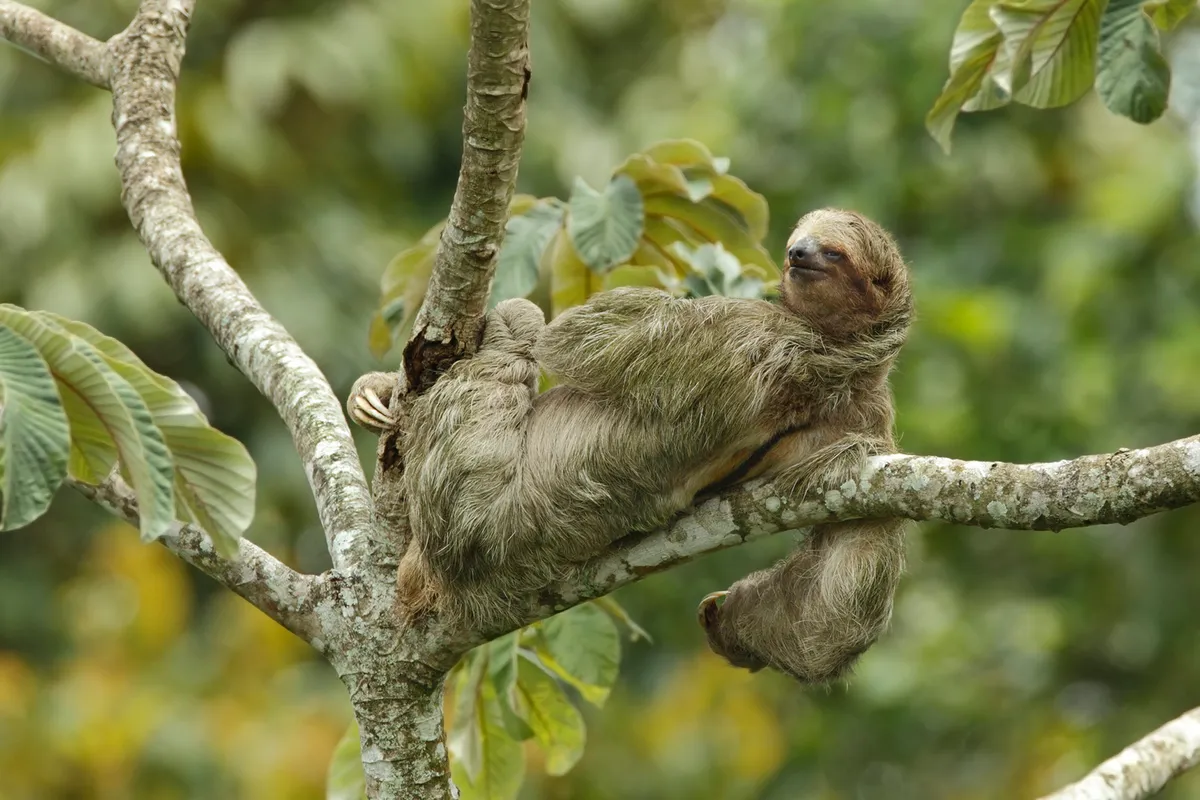
They save energy by being inactive or little active for most of the time. Studies investigating electroencephalographic data have revealed that brown-throated sloths sleep for about nine hours and are awake for the remaining 15 hours out of the 24 hour cycle.
This implies that sloths, contrary to common belief, don’t sleep most of the time. What differentiates them from most other animals is that when active, such as eating, moving or travelling, they do that slowly and carefully, expending little energy in the process.
They also move for short distances on a daily basis, rarely going further than 30 m a day, studies indicate, although occasionally they can cover distances 10 times longer. Last, their thick fur is very efficient at keeping the body heat insulated from external temperature.
Nevertheless, even with an insulating fur sloths don't regulate their body heat very well, so that their body temperature can vary a bit according to the environmental temperature.
They are endotherms like all mammals but rather poor ones. When temperature drops too much sloths don't shiver to warm themselves, which is one more mechanism to save energy.
On the other hand, that is one more reason why sloths are not able to survive outside the tropical forests, preferring warm places with small seasonal variation in temperature.
How do sloths sleep?
They can sleep either in a sitting position (Bradypus) or suspended upside down under tree branches (both sloth genera, but mostly Choloepus), generally well hidden high up in the tree canopy.
Two-toed sloths sleep during daytime while three-toed sloths can sleep during day or at night.
Are sloths blind?
Sloths are not blind but their eyesight is poor. Studies indicate that the sloth eyes show adaptations to night vision, likely reflecting the fact that they can be active at night and some individuals or species being exclusively so. Smell is the most accurate of the senses of a sloth.
So, they probably go around combining visual and olfactory cues from the environment.
What sound do sloths make?
Sloths can emit a whistle-like sound when stressed or when searching for partners.
In fact one Indigenous name of Bradypus sloths is “ai” which very accurately reflects the nature of their whistle-like call (something like “aeeh” in English pronunciation).
On the other hand, the sound of Choloepus sloths is something like "unau", which is also their indigenous name.
What is a sloth's diet?

Sloths are quintessentially folivores, that is, they feed almost exclusively on leaves from trees, vines and lianas. Only rarely they eat flowers, fruits or other items.
Among leaves, they prefer the young, tenderer ones more than mature leaves. But the literature on sloth diet in the wild comes mostly from three-toed sloths, which can be active during the day and therefore can be observed by researchers.
We know much less about the diet of the nocturnal two-toed sloths as they feed solely at night. Under human care two-toed sloths can consume a variety of items, including vegetables, even cooked ones, fruits and even meat.
Due to this predisposition to a more varied diet, two-toed sloths are more commonly kept under human care at zoological institutions. However, they should not be kept as pets.
Three-toed sloths, however, do not accept other food items than leaves and do not survive more than a few weeks or months under human care.
Do sloths have any predators and how do they defend themselves?
Sloths are prey to large raptors, jaguars, pumas, ocelots and, occasionally also by other smaller carnivores such as the tayra. There is even a report of predation event by an owl.
Their first and most successful strategy of defence against predation is by hiding high up in the forest canopy for most of the time and, of course, by their way to move around slowly and silently.
If that however fails they try to defend themselves by violent swings of their arms and claws (both two and three-toed sloths) and by trying to bite the opponent (mainly two-toed sloths; three-toed sloths only occasionally do try to bite).
Please note that external videos may contain ads:
Three-Toed Sloth Survives 6m Fall From The Treetops | VR 360 | Seven Worlds, One Planet |BBC Earth
Why do sloths hang upside-down?
Bradypus species of sloths can rest upside down but most of the time they sleep and rest “sitting” above branch joints anchoring themselves in the tree trunk.
Both three and two-toed sloths however hang upside down during locomotion, which is an inverse form of the typical quadrupedal locomotion of terrestrial mammals.
Studies on musculature of sloths suggest that digging adaptations of early sloth ancestors, probably imposed constraints that eventually led to the evolution of the suspensory posture.
Since both two and three-toed sloths are distantly related but show this same locomotor behaviour it is a case of convergent evolution.
Please note that external videos may contain ads:
Mouldy Sloth | Amazon Assassin | BBC Earth
How often do sloths poop?
Sloths poop on the ground once every week or so. They slowly descend the tree and reach the forest floor.
Once there, three-toed sloths make a small hole in the forest litter with their short tail, deposit their faeces, which are round pellets the size of a pea, and urine and then climb back to the canopy.
What threats do sloths face and are they endangered?
Of the six existing sloths, two are endangered: the pygmy sloth and the maned sloth.
The pygmy three-toed sloth is listed as Critically Endangered on the IUCN Red List because it inhabits solely a tiny island of less than 5 km2 (Escudo de Veraguas) off the coast of Panama and the forest it inhabits is being disturbed by human activities.
The maned three-toed sloth is endemic of Brazil, inhabiting the coastal forests of this country, which is today reduced to less than 12 % of its original extent. It is listed as Vulnerable on the IUCN Red List.
Ongoing deforestation and forest disturbance resulting from cattle ranching, agriculture, city sprawl and real estate market are the main causes of population decline of this sloth.
The other four extant species are listed as Least Concern on the IUCN Red List.
The IUCN SSC Anteater, Sloth and Armadillo Specialist Group evaluates the conservation status of the xenarthran species for the IUCN Red List. There are 32 extant (living) species of xenarthans: ten anteaters, six sloths and 22 armadillos.
Is there any difference between a pygmy sloth and other sloths apart from size?
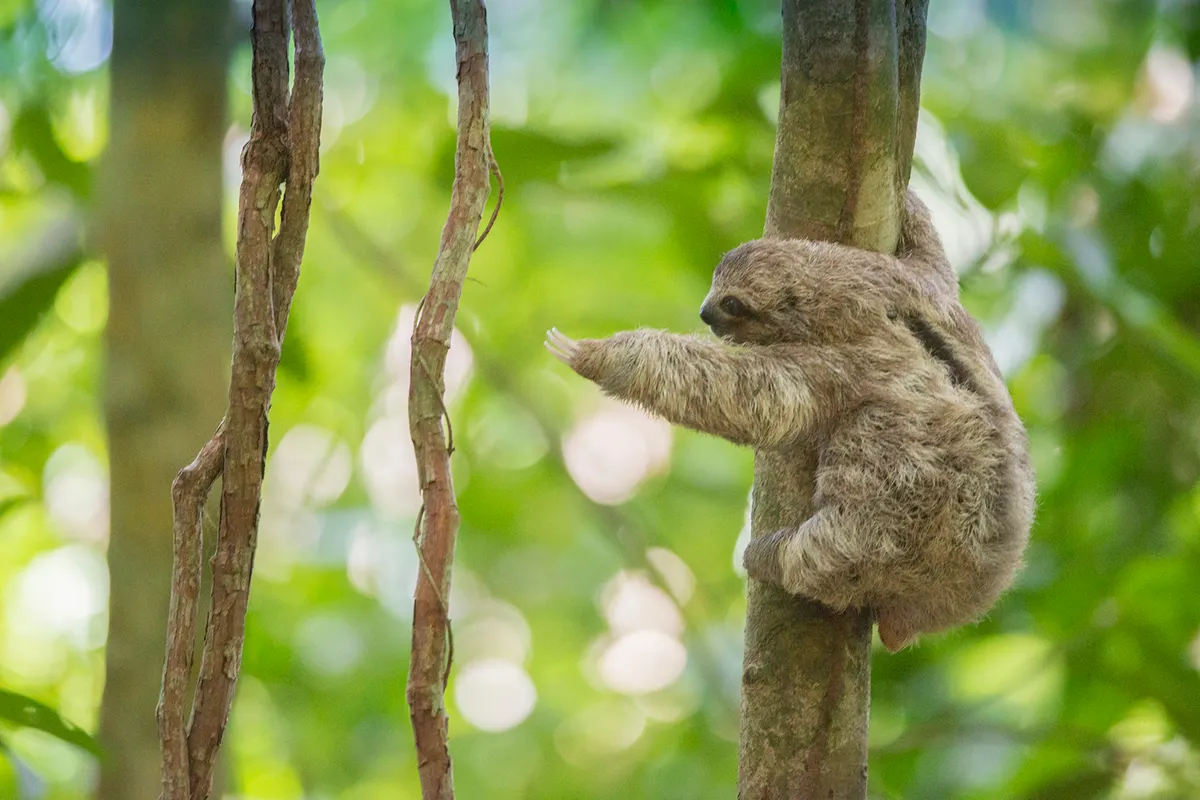
The pygmy sloth is similar in pelage colouration to the brown-throated sloth, but has a smaller size and some differences in the cranium.
Why did giant sloths become extinct?
Giant ground sloths had the same fate of several other species of large mammals and birds at the end of the Pleistocene, some 10 kya (thousand years ago) in Continental America and 5-4 kya in some Caribbean Islands.
Several hypotheses have been put forward to explain the demise of these giants, including disease and even an impact of an extra-terrestrial asteroid similar to the one that wiped out the Dinosaurs 60 million years ago.
But among them, two have received more attention and support: environmental modification due to climate change and hunting by humans.
Giant ground sloths and other large Xenarthrans such as Glyptodonts and Pampatheres were all herbivores inhabiting the open areas dominated by shrubby or grassy vegetation of South and North America during most of the Tertiary, when cold and dry conditions predominated.
But at the end of the Pleistocene increasing temperature and humidity caused a shrinkage of these open environments from where these giants obtained their food. Without adequate habitat, their population slowly but steadily collapsed.
The alternative hypothesis links this demise, however, to the arrival of humans in the Americas via Bering Sea about 12 kya, according to the most accepted chronology.
From North America they passed to South America and only later arrived in the Caribbean Islands. The timing of the human arrival is more or less coincident with the disappearing time of large mammals, including ground sloths and the other larger Xenarthrans and large mammals from other orders.
There are pros and cons of these two hypotheses and perhaps the most likely scenario included a bit of the two.
Please note that external videos may contain ads:
The 'Busy' Life of the Sloth | BBC Earth
What is the scientific name for a sloth?
Sloths are divided into two genera, Bradypus, which means “slow footed” and Choloepus, meaning “lame footed”.
There are two families of sloths: Megalonychidae, the two-toed sloths, and Bradypodidae, which include the three-toed sloths.
Both families belong to the suborder Folivora, and to the higher Pilosa order, which also includes the 10 extant species of anteater:
- Giant anteater (Myrmecophaga tridactyla)
- Amboro silky anteater (Cyclopes catellus)
- Common silky anteater (Cyclopes didactylus)
- Central American silky anteater (Cyclopes dorsalis)
- Río Negro silky anteater (Cyclopes ida)
- Red silky anteater (Cyclopes rufus)
- Thomas’s silky anteater (Cyclopes thomasi)
- Xingu silky anteater (Cyclopes xinguensis)
- Northern tamandua (Tamandua mexicana)
- Southern tamandua (Tamandua tetradactyla).
How do you pronounce sloth?
Should it rhyme with 'moth' or 'both'? Opinion is divided. And it's quite probably another example of what playwright George Bernard Shaw described as "two nations separated by a common language". He was referring to England and the United States, and the pronunciation of sloth depends in part as to where you come from.
The traditional British English pronunciation rhymes with 'both', while the American English way of saying sloth is to rhyme with 'moth'. However, in recent times, the US version has become increasingly common in the UK. Since Sir David Attenbo
Main image: Sloth hanging from a tree in Costa Rica. © Jonathan Ross/Getty
